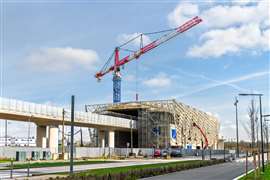Read this article in French German Italian Portuguese Spanish
Why are some construction workers now being asked to wear body cameras?
07 December 2023
 A worker installs cladding on a high-rise building (Image: Mick Tsikas/AAP)
A worker installs cladding on a high-rise building (Image: Mick Tsikas/AAP)
They are more commonly seen being worn by emergency services and law enforcement personnel.
But a major insurance company has started to require contractors working on the remediation of combustible cladding to wear body cameras so that it can monitor the quality of the work and keep it for future reference.
The announcement from AXA UK came last week, in reference to work to remove combustible cladding and insulation from high-rise, multi-occupancy buildings in the wake of the Grenfell Tower tragedy, which killed 72 people in June 2017.
But how will such an initiative work and could the use of body cameras in construction widen in the future?
AXA UK said it had launched the requirement for contractors to wear cameras because poor workmanship and unsuitable materials – for example combustible insulation – can be hidden under external cladding.
That makes evidence of what work was actually carried out and what materials were used hard to trace.
The insurance company itself has already been using the cameras to capture commercial risks for underwriters to review.
Now, it will require contractors in the UK to use Motorola Solutions VT100 body cameras when responding to incidents.
These can be live streamed if required so that contractors can liaise directly with AXA risk engineers.
How it will work
Responding to questions from the Construction Briefing, AXA UK said that it wanted the cameras to apply to “as many remediation projects” as possible, although it did not give a precise number, nor how many cameras for contractors it was investing in.
Currently, the insurer has agreed a seven-year retention agreement with contractors for the footage, which will be stored in the cloud.
But contractors won’t be expected to record every single moment of their work. Instead, they might be required to record a 30-minute weekly or bi-weekly overview of work completed, depending on the size and complexity of a project. That means that battery life of the camera is unlikely to be a major obstacle.
“There will not be an expectation for cameras to be in use at all times. Instead, we expect that contractors will provide us with weekly or biweekly updates to give an overview of the work completed,” a spokesperson explained.
“There may be times when we will agree specific footage requirements in advance but every risk will be different and we will work with contractors to provide video footage of site working practices to ensure there is proper management of materials being removed, storage of new materials, and security/arson prevention.
“Voice recording is also included, so it should be easily achievable to do a walk-around where the works completed are described. As part of this initiative, we will be arranging regular visits during each project timeline for the in-house AXA risk engineering team to discuss any ongoing requirements,” they added.
As far as the issue of consent and whether the workers themselves will be happy to be recorded in their work, AXA said that the camera software has “full redaction tools”. While the footage stored to the cloud can’t be edited, the faces of individuals can be anonymised if shared with others.
Will body cameras become more common in construction?
It is thought to be one of the first times body cameras have been used to monitor the quality of construction work in this way.
But the industry is already familiar with the technology as it is often worn by site security personnel. That means some construction companies are already likely to be familiar with requirements around data storage and management, even if using the cameras as a tool to monitor construction processes is a more recent development.
As the industry continues along its path to embracing digital technology, these more novel uses of body cameras could start to become more common, particularly as companies look to phase out written processes in favour of video evidence.
That could come in the form of providing a digital record of work quality as in the case of AXA’s contractors, but also as proof of delivery of materials, audit and quality assurance in respect of machinery installation and maintenance, and recording of other important business processes.
Fergus Mayne, UK and Ireland country manager at Motorola Solutions said, “Body cameras are proving to be an increasingly useful tool across a variety of industry sectors and use cases. By providing an objective record of events which can be easily captured, stored and utilised, body cameras are helping organisations to operate more effectively and provide value to their customers.”
STAY CONNECTED



Receive the information you need when you need it through our world-leading magazines, newsletters and daily briefings.
CONNECT WITH THE TEAM










